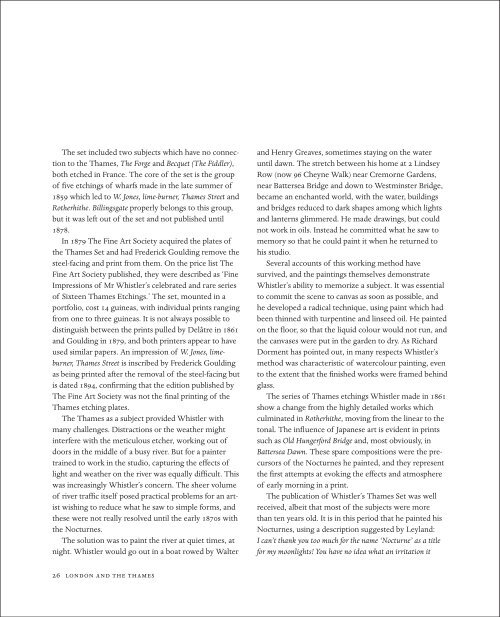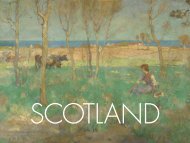You also want an ePaper? Increase the reach of your titles
YUMPU automatically turns print PDFs into web optimized ePapers that Google loves.
The set included two subjects which have no connection<br />
to the Thames, The Forge and Becquet (The Fiddler),<br />
both etched in France. The core of the set is the group<br />
of five etchings of wharfs made in the late summer of<br />
1859 which led to W. Jones, lime-burner, Thames Street and<br />
Rotherhithe. Billingsgate properly belongs to this group,<br />
but it was left out of the set and not published until<br />
1878.<br />
In 1879 The Fine Art Society acquired the plates of<br />
the Thames Set and had Frederick Goulding remove the<br />
steel-facing and print from them. On the price list The<br />
Fine Art Society published, they were described as ‘Fine<br />
Impressions of Mr Whistler’s celebrated and rare series<br />
of Sixteen Thames Etchings.’ The set, mounted in a<br />
portfolio, cost 14 guineas, with individual prints ranging<br />
from one to three guineas. It is not always possible to<br />
distinguish between the prints pulled by Delâtre in 1861<br />
and Goulding in 1879, and both printers appear to have<br />
used similar papers. An impression of W. Jones, limeburner,<br />
Thames Street is inscribed by Frederick Goulding<br />
as being printed after the removal of the steel-facing but<br />
is dated 1894, confirming that the edition published by<br />
The Fine Art Society was not the final printing of the<br />
Thames etching plates.<br />
The Thames as a subject provided Whistler with<br />
many challenges. Distractions or the weather might<br />
interfere with the meticulous etcher, working out of<br />
doors in the middle of a busy river. But for a painter<br />
trained to work in the studio, capturing the effects of<br />
light and weather on the river was equally difficult. This<br />
was increasingly Whistler’s concern. The sheer volume<br />
of river traffic itself posed practical problems for an artist<br />
wishing to reduce what he saw to simple forms, and<br />
these were not really resolved until the early 1870s with<br />
the Nocturnes.<br />
The solution was to paint the river at quiet times, at<br />
night. Whistler would go out in a boat rowed by Walter<br />
and Henry Greaves, sometimes staying on the water<br />
until dawn. The stretch between his home at 2 Lindsey<br />
Row (now 96 Cheyne Walk) near Cremorne Gardens,<br />
near Battersea Bridge and down to Westminster Bridge,<br />
became an enchanted world, with the water, buildings<br />
and bridges reduced to dark shapes among which lights<br />
and lanterns glimmered. He made drawings, but could<br />
not work in oils. Instead he committed what he saw to<br />
memory so that he could paint it when he returned to<br />
his studio.<br />
Several accounts of this working method have<br />
survived, and the paintings themselves demonstrate<br />
Whistler’s ability to memorize a subject. It was essential<br />
to commit the scene to canvas as soon as possible, and<br />
he developed a radical technique, using paint which had<br />
been thinned with turpentine and linseed oil. He painted<br />
on the floor, so that the liquid colour would not run, and<br />
the canvases were put in the garden to dry. As Richard<br />
Dorment has pointed out, in many respects Whistler’s<br />
method was characteristic of watercolour painting, even<br />
to the extent that the finished works were framed behind<br />
glass.<br />
The series of Thames etchings Whistler made in 1861<br />
show a change from the highly detailed works which<br />
culminated in Rotherhithe, moving from the linear to the<br />
tonal. The influence of Japanese art is evident in prints<br />
such as Old Hungerford Bridge and, most obviously, in<br />
Battersea Dawn. These spare compositions were the precursors<br />
of the Nocturnes he painted, and they represent<br />
the first attempts at evoking the effects and atmosphere<br />
of early morning in a print.<br />
The publication of Whistler’s Thames Set was well<br />
received, albeit that most of the subjects were more<br />
than ten years old. It is in this period that he painted his<br />
Nocturnes, using a description suggested by Leyland:<br />
I can’t thank you too much for the name ‘Nocturne’ as a title<br />
for my moonlights! You have no idea what an irritation it<br />
proves to the critics and consequent pleasure to me, – besides<br />
it is really so charming and does so poetically say all I want to<br />
say and no more than I wish.*<br />
Whistler’s Thames etchings of the later 1870s such as<br />
Price’s Candle Factory and Battersea Morn, show an increasing<br />
economy of line and may be seen as an attempt to<br />
find equivalents in etching and drypoint for the paintings<br />
of the period which culminated in Nocturne in Black and<br />
Gold: The Falling Rocket, exhibited at the first Grosvenor<br />
Gallery exhibition in 1877. The painting was the subject<br />
of a review by John Ruskin who wrote:<br />
I have seen, and heard, much of Cockney impudence before<br />
now; but never expected to hear a coxcomb ask two hundred<br />
guineas for flinging a pot of paint in the public’s face.<br />
Ruskin was the most influential art critic of his<br />
time, and his attack on Whistler’s paintings made them<br />
essentially unsaleable. It coincided with the termination<br />
of Leyland’s patronage and his refusal to pay the artist<br />
for his decoration of the Peacock Room at his home in<br />
Prince’s Gate. In September 1877 Whistler was due to<br />
sign a contract with the architect E.W. Godwin for the<br />
design and construction of The White House, to be built<br />
on Tite Street, Chelsea. It was to be a masterpiece of<br />
avant-garde architecture and the aesthetic movement but<br />
financial disaster loomed.<br />
Whistler decided to sue Ruskin for libel. Although he<br />
won the celebrated case, he was not awarded costs and<br />
only one farthing in damages; he was ultimately declared<br />
bankrupt. Searching for income and intending to defend<br />
his artistic reputation, he turned once more to the<br />
Thames, the source of his early success in London.<br />
It was at about this time that Ernest Brown came to<br />
see him with a view to publishing an etching in an issue<br />
of Portfolio magazine. Whistler gave him the plate of<br />
* An undated letter from Whistler to Leyland in the Library of<br />
Congress, Washington D.C., J. and E.R. Pennell Collection<br />
Billingsgate, done in 1859, which had not been included<br />
in the Thames Set, and it was published in January 1878.<br />
Simultaneously, he was encouraged to make prints in<br />
a new medium by Thomas Way, a lithographic printer.<br />
This enabled him to achieve effects much closer to those<br />
in his painted Nocturnes than was possible in etching<br />
or drypoint. Way had suggested publishing a group of<br />
lithographs in a set to be called Art Notes. With his trial<br />
over Ruskin’s libel approaching, its publication might<br />
have enabled Whistler to foster interest in and understanding<br />
of his new work, but there was little interest in<br />
the project from the public.<br />
By1879 Ernest Brown had joined the staff of The<br />
Fine Art Society, and, no doubt at his suggestion, the<br />
company bought the Thames Set plates from Ellis<br />
& Green, and engaged Frederick Goulding to print a<br />
second edition. Since Art Notes had been a commercial<br />
failure, instead of further lithographs, Whistler<br />
embarked on a series of new etchings of the Thames,<br />
including Old Putney Bridge. These were to be the last<br />
prints Whistler made of the Thames for nearly a decade.<br />
In September 1879 he left London for Venice.<br />
After Whistler’s return to London in November 1880<br />
he re-established himself as one of the foremost artists<br />
of his time. He moved back to Tite Street in Chelsea<br />
and exhibitions of the prints and pastels he had made in<br />
Venice enhanced his reputation. The streets of London<br />
remained a source of subjects.<br />
26 london and the thames james mcneill whistler: prints 27



